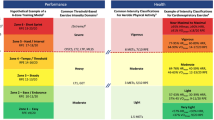Summary
Restitution of the EMG spectrum was studied in upper limb muscles. The subjects performed isometric and isotonic exercises until they refused because of fatigue. Force levels varied from 15 to 60% MVC. The mean frequency was used as an indicator of the modification of the spectrum. Restitution of the EMG spectrum was studied by recording for 10 min after the end of the fatigue experiment at intervals of 1 to 3 minutes. Recovery was rapid at the beginning, levelling off to a plateau in 2 to 5 min. The change was more regular in isometric experiments than in kinetic ones, although interindividual differences were large in both cases.
Similar content being viewed by others
References
Buchthal F, Madsen A (1950) Synchronous activity in normal and atrophic muscle. EEG Clin Neurophysiol 2:425–444
DeLuca CJ, Creigh JL (1985) Do the firing statistics of motor units modify the frequency content of the EMG signal during sustained contractions? Biomechanics IXA. In: Winter DA (ed) Human Kinetics Publishers Inc, Champaign, Ill., USA, pp 358–362
Ericsson BE, Hagberg M (1979) EMG power spectra versus muscular contraction level. Acta Neurol Scand [Suppl] 73:60–163
Fallentin N, Sidenius B, Jørgensen K (1985) Blood pressure, heart rate and EMG in low level static contractions. Acta Physiol Scand 125:265–275
Fay DF, Jones NB, Porter NH (1976) Spectral analysis of the myo-electric activity of the pelvic floor during voluntary contractions. Electromyogr Clin Neurophysiol 16:525–551
Fex J, Krakau ET (1957) Some experiences with Walton's frequency analysis of the electromyogram. J Neurol Neurosurg Psychiat 20:178–184
Funderburgh CF, Hipskind SG, Welton RC, Lind AR (1974) Development of and recovery from fatigue induced by static effort at various tension. J Appl Physiol 37:392–396
Gander RE, Hudgins BS (1985) Power spectral density of the surface myoelectric signal of the biceps brachii as a function of static load. Electromyogr Clin Neurophysiol 25:469–478
Hara T (1980) Evaluation of recovery from local muscle fatigue by voluntary test contractions. J Human Ergol 9:35–46
Häkkinen K, Komi PV (1983) Electromyographic and mechanical characteristics of human skeletal muscle during fatigue under voluntary and reflex conditions. Electroencephalogr Clin Neurophysiol 55:436–444
Johansson S, Larsson LE, Örtengren R (1970) An Automated method for the frequency analysis of myoelectric signal evaluated by an investigation of the spectral changes following strong sustained contractions. Med Biol Eng 8:257–264
Johnson MA, Polgar J, Weightman D, Appleton D (1973) Data on the distribution of fibre types in thirty-six human muscles. An autopsy study. J Neurol Sci 18:111–129
Jonsson B (1978) Quantitative electromyographic evaluation of muscular load during work. Scand J Rehab Med [Suppl] 6:69–74
Kadefors R, Kaiser E, Petersen I (1968) Dynamic spectrum analysis of myo-potentials and with special reference to muscle fatigue. Electromyography 8:39–73
Kogi K, Hakamada T (1962) Slowing of surface electromyogram and muscle strength in muscle fatigue. Report 60:27–41. Institute for Science of Labour, Tokyo
Kramer H, Lun A, Mucke R, Küchler G (1979) Changes in mechanical and bioelectrical muscular activity and in heart rate due to sustained voluntary isometric contractions and time required for recovery. Electromyogr Clin Neurophysiol 19:381–386
Kuorinka I (1976) Assessment of muscular fatigue with the spectral analysis of myoelectric potentials. Academic dissertation, Helsinki
Larsson LE, Linderholm H, Ringqvist T (1965) The Effect of Sustained and Rhythmic Contractions on the Electromyogram (EMG). Acta Physiol Scand 65:310–318
Lindström L, Magnusson R, Petersen I (1970) Muscular fatigue and action potential conduction velocity changes studied with frequency analysis of EMG signals. Electromyography 4:341–356
Lindström L, Kadefors R, Petersen I (1977) An electromyographic index for localized muscle fatigue. J Appl Physiol.: Respirat Environ Exercise Physiol 43:750–754
Lippold OCJ (1967) In: Venables I, Martin I (eeds) A manual of psychophysiological methods. North Holland, Amsterdam
Mills KR (1982) Power spectral analysis of electromyogram and compound muscle action potential during muscle fatigue and recovery. J Physiol 326:401–409
Mortimer JT, Magnusson R, Petersen I (1970) Conduction velocity in ischemic muscle: effect on EMG frequency spectrum. Am J Physiol 219:1324–1329
Petrofsky JS (1981) Quantification through the surface EMG of muscle fatigue and recovery during successive isometric contractions. Aviat Space Environ Med Sept.:545–550
Petrofsky JS, Lind AR (1980) Frequency analysis of the surface electromyogram during sustained isometric contractions. Eur J Appl Physiol 43:173–182
Rohmert W (1959) Ermittlung von Erholungszuschlägen bei statischer Arbeit des Menschen. Dissertation, Technische Hochschule Aachen
Stulen FB, DeLuca CJ (1981) Frequency parameters of the myoelectric signal as a measure of muscle conduction velocity. IEEE Trans Biomed Eng 28:515–523
Walton JN (1952) The electromyogram in myopathy: Analysis with the audiofrequency spectrometer. J Neurol Neurosurg Psychiatr 15:219–226
Viitasalo JT, Komi PV (1980) EMG, reflex and reaction time components, muscle structure, and fatigue during intermittent isometric contractions in man. Int J Sports Med 1:185–190
Author information
Authors and Affiliations
Rights and permissions
About this article
Cite this article
Kuorinka, I. Restitution of EMG spectrum after muscular fatigue. Europ. J. Appl. Physiol. 57, 311–315 (1988). https://doi.org/10.1007/BF00635989
Accepted:
Issue Date:
DOI: https://doi.org/10.1007/BF00635989




